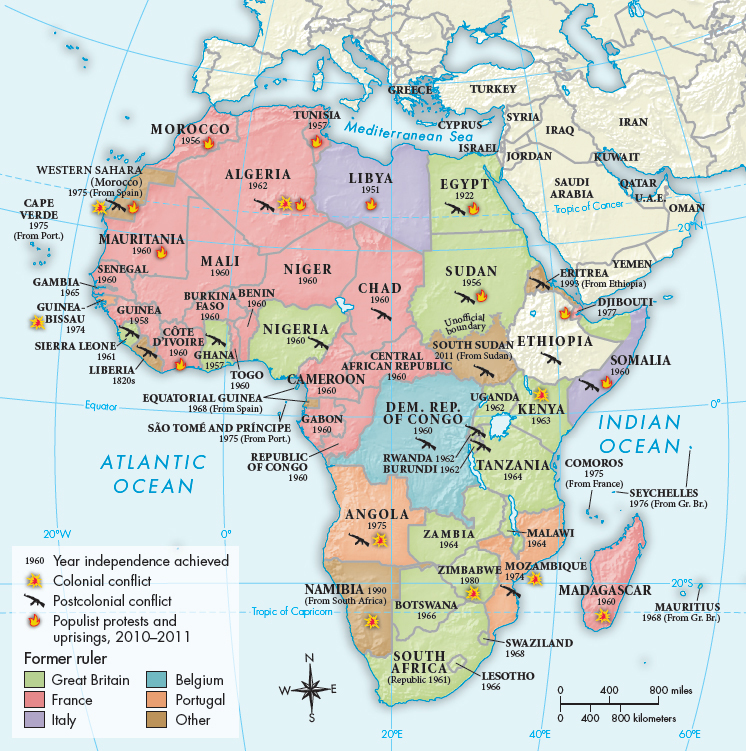The Growth of African Nationalism
African nationalism resembled similar movements in Asia and the Middle East in its reaction against European colonialism, but there were two important differences. First, because the imperial system and Western education did not solidify in Africa until after 1900 (see “Colonialism’s Impact After 1900” in Chapter 25), national movements came of age in the 1920s and reached maturity after 1945. Second, Africa’s multiplicity of ethnic groups, coupled with colonial boundaries that often bore no resemblance to existing ethnic geography, greatly complicated the development of political — as distinct from cultural — nationalism. Was a modern national state based on ethnic or clan loyalties? Was it to be a continent-wide union of all African peoples? Would the multiethnic territories carved out by European empires become the new African nations? Such questions were not fully addressed until after 1945.
The first nationalist impetus came from the United States and the Caribbean. The most renowned participant in this “black nationalism” was W. E. B. Du Bois (1868–1963). The cofounder of the National Association for the Advancement of Colored People (NAACP) in the United States, Du Bois organized Pan-African congresses in Paris during the Paris Peace Conference in 1919 and in Brussels in 1921. Pan-Africanists sought black solidarity and, eventually, a vast self-governing union of all African peoples. Jamaican-born Marcus Garvey (1887–1940) was the most influential Pan-Africanist, rallying young, educated Africans to his call of “Africa for the Africans.”
In the 1920s a surge of anticolonial nationalism swept educated Africans in French and British colonies. African intellectuals in Europe formulated and articulated négritude, or blackness: racial pride, self-confidence, and joy in black creativity and the black spirit. This westernized African elite pressed for better access to government jobs, modest steps toward self-government, and an end to humiliating discrimination.
The mass protests that accompanied the deprivations of the Great Depression, in particular the cocoa holdups of 1930–1931 and 1937–1938, fueled the new nationalism. Cocoa dominated the British colonial economy in the Gold Coast (which became Ghana). As prices plummeted after 1929, cocoa farmers refused to sell their beans to the British firms that fixed prices and monopolized exports. Now farmers organized cooperatives to cut back production and sell their crops directly to European and American chocolate manufacturers. The cocoa holdups mobilized the population against the foreign companies and demonstrated the power of mass organization and protest.
The repercussions of the Second World War in Africa greatly accelerated the changes begun in the 1930s. Many African soldiers who served in India had been powerfully impressed by Indian nationalism. As African mines and plantations strained to meet wartime demands, towns mushroomed into cities, which became centers of discontent and hardship.
Western imperialism also changed. The principle of self-government was written into the United Nations charter and was supported by Great Britain’s postwar Labour government. Thus the key issue for Great Britain’s various African colonies was their rate of progress toward self-government. The British and the French were in no rush, but an emerging group of African nationalist leaders was less patient. These postwar African leaders formed an elite by virtue of their advanced Western education, and they were profoundly influenced by Western thought. But compared with the interwar generation of educated Africans, they were more radical and had humbler social origins.
Postwar African nationalists pragmatically accepted prevailing colonial boundaries to avoid border disputes and achieve freedom as soon as possible. Sensing a loss of power, traditional rulers sometimes became the new leaders’ worst political enemies. Skillfully, the new leaders channeled postwar hope and discontent into support for mass political organizations that offset this traditional authority. These organizations staged gigantic protests and became political parties.

MAP 31.5Decolonization in Africa, 1947 to the PresentMost African territories achieved statehood by the mid-1960s, as European empires passed away, unlamented.> MAPPING THE PASTANALYZING THE MAP: How many African states achieved independence after 1945? How many experienced some sort of postcolonial conflict?CONNECTIONS: How did the imperialist legacy serve to complicate the transition to stable, independent nations in Africa and Latin America?
